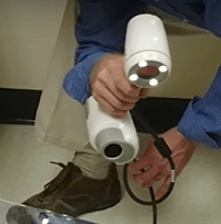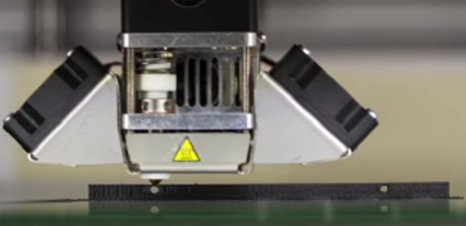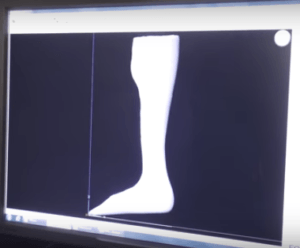Michigan Engineering Develops New Cyber Manufacturing System to Quickly Design and 3D Print Custom Orthotics and Prosthetics
![]() In early 2016, the University of Michigan Orthotics and Prosthetics Center (UMOPC) teamed up with Stratasys and Altair Engineering to form the CYBER team, which was funded by America Makes and aimed to leverage 3D printing and Industry 4.0 to make better Ankle Foot Orthotics, and more specifically to address the orthotics needs of veterans. The work the CYBER team did paved the way for a new project: UMOPC recently implemented a new cyber manufacturing system that was developed by the University of Michigan College of Engineering, in an effort to quickly design and 3D print custom, better-fitting orthotics and prosthetics for stroke patients, amputees, and people with cerebral palsy.
In early 2016, the University of Michigan Orthotics and Prosthetics Center (UMOPC) teamed up with Stratasys and Altair Engineering to form the CYBER team, which was funded by America Makes and aimed to leverage 3D printing and Industry 4.0 to make better Ankle Foot Orthotics, and more specifically to address the orthotics needs of veterans. The work the CYBER team did paved the way for a new project: UMOPC recently implemented a new cyber manufacturing system that was developed by the University of Michigan College of Engineering, in an effort to quickly design and 3D print custom, better-fitting orthotics and prosthetics for stroke patients, amputees, and people with cerebral palsy. Currently, when a patient needs a custom assistive device like orthoses (braces used to protect, improve, or align function and stability to injured limbs) or prostheses (devices used to replace a lost limb), they have to wait for days, and sometimes even weeks, for one to be fabricated. The UM clinicians and engineers who designed the system said it will create custom, lightweight devices much faster, and additionally can improve the fit, function, consistency, and precision of each device.
Currently, when a patient needs a custom assistive device like orthoses (braces used to protect, improve, or align function and stability to injured limbs) or prostheses (devices used to replace a lost limb), they have to wait for days, and sometimes even weeks, for one to be fabricated. The UM clinicians and engineers who designed the system said it will create custom, lightweight devices much faster, and additionally can improve the fit, function, consistency, and precision of each device.
Albert Shih, project lead and professor of mechanical and biomedical engineering at the University of Michigan, said, “Eventually we envision that a patient could come in in the morning for an optical scan, and the clinician could design a high quality orthosis very quickly using the cloud-based software. By that afternoon, they could have a 3-D printed device that’s ready for final evaluation and use.”
The team is currently focused on one specific device: ankle foot orthoses, generally prescribed to help stroke patients regain the ability to walk independently. There are 700,000 stroke victims in the US each year, and over two-thirds of these need long-term rehabilitation, which can be helped with custom orthotics like the ones UM is working on. Children with myelomeningocele and cerebral palsy can also use these types of devices to regain stability while walking.
 To make the custom assistive device, the patient will first have to undergo a 3D optical scan, and the orthotist will then upload the scan data to a cloud-based design center and use software, specially developed by Altair Engineering and Standard Cyborg, to design the device. A set of electronic instructions is created by the software and transmitted directly to the orthotist’s facility, where an onsite Stratasys Fortus 400mc 3D printer will create the device itself in a matter of hours.
To make the custom assistive device, the patient will first have to undergo a 3D optical scan, and the orthotist will then upload the scan data to a cloud-based design center and use software, specially developed by Altair Engineering and Standard Cyborg, to design the device. A set of electronic instructions is created by the software and transmitted directly to the orthotist’s facility, where an onsite Stratasys Fortus 400mc 3D printer will create the device itself in a matter of hours.
This is a “major departure from current methods” of creating assistive devices, according to Jeff Wensman, director of clinical and technical services at UMOPC. The current labor-intensive process, which usually takes about two weeks, needs a highly trained staff and large shop to complete all of the steps, which include:
- Wrapping fiberglass tapes around the patient’s limb, which will harden into a mold
- Filling the mold with plaster to make the model
- Vacuum forming heated plastic around the model to make the device
- Smoothing the edges by hand and attaching mechanical components, such as straps
The new process developed by UMOPC only needs three pieces of equipment on-site: a handheld optical scanner, a computer, and a 3D printer; as the Fortus 400mc is only about 4′ x 3′ x 6.5′, the lab or shop itself won’t even need to be that big. So in the future, even smaller clinics located in more rural or remote areas could better accommodate patients who need these types of custom devices.
 The system, developed by UM mechanical engineering PhD student Robert Chisena, utilizes a new type of infill pattern: a wave, or parse structure, which creates a wavy, continuous infill pattern, and makes the orthotics partially hollow. This not only saves weight while retaining strength, it also helps increase the machine’s efficiency.
The system, developed by UM mechanical engineering PhD student Robert Chisena, utilizes a new type of infill pattern: a wave, or parse structure, which creates a wavy, continuous infill pattern, and makes the orthotics partially hollow. This not only saves weight while retaining strength, it also helps increase the machine’s efficiency.
Wensman said, “Traditional hand-made orthotics are solid plastic, and they need to be a certain thickness because they have to be wrapped around a physical model during the manufacturing process. 3-D printing eliminates that limitation. We can design devices that are solid in some places and hollow in others and vary the thickness much more precisely. It gives us a whole new set of tools to work with.”
 The new process is also more consistent than existing methods, since it utilizes computer-based models instead of hand fabrication. So any clinic that owns a 3D printer will be able to create the exact same device over and over again. Doctors will also be able to see how a patient’s shape and condition are progressing, as they have access to computer models of previously used orthotics for the patient. Shih says the device is already creating and testing prosthetics and orthotics, and the team is working on a plan to show how their new process will be able to improve both efficiency and service, as well as reduce the overall cost. So other healthcare providers are able to benefit from their work and develop similar systems, the team will be making their system specs and software available for free.
The new process is also more consistent than existing methods, since it utilizes computer-based models instead of hand fabrication. So any clinic that owns a 3D printer will be able to create the exact same device over and over again. Doctors will also be able to see how a patient’s shape and condition are progressing, as they have access to computer models of previously used orthotics for the patient. Shih says the device is already creating and testing prosthetics and orthotics, and the team is working on a plan to show how their new process will be able to improve both efficiency and service, as well as reduce the overall cost. So other healthcare providers are able to benefit from their work and develop similar systems, the team will be making their system specs and software available for free.
Along with America Makes and Manufacturing USA, the project received funding from the National Science Foundation.
Shih said, “Without America Makes and Manufacturing USA, we would not be able to bring a state-of-the-art 3D printer to the prosthetics center with the traditional research project. Without the National Science Foundation’s Partnership for Innovation and cyber manufacturing grants, we would not be able to have PhD engineering students working at UMOPC to develop the system. I am very blessed to have all three projects funded and started at the same time to create this first-of-its-kind demonstration site at UMOPC for the Michigan Difference in advanced manufacturing and patient care.”
Check out the 3D Printed Orthotics video to learn more:
Discuss in the University of Michigan forum at 3DPB.com.
[Source/Images: University of Michigan]
Subscribe to Our Email Newsletter
Stay up-to-date on all the latest news from the 3D printing industry and receive information and offers from third party vendors.
You May Also Like
Profiling a Construction 3D Printing Pioneer: US Army Corps of Engineers’ Megan Kreiger
The world of construction 3D printing is still so new that the true experts can probably be counted on two hands. Among them is Megan Kreiger, Portfolio Manager of Additive...
US Army Corps of Engineers Taps Lincoln Electric & Eaton for Largest 3D Printed US Civil Works Part
The Soo Locks sit on the US-Canadian border, enabling maritime travel between Lake Superior and Lake Huron, from which ships can reach the rest of the Great Lakes. Crafts carrying...
Construction 3D Printing CEO Reflects on Being Female in Construction
Natalie Wadley, CEO of ChangeMaker3D, could hear the words of her daughter sitting next to her resounding in her head. “Mum, MUM, you’ve won!” Wadley had just won the prestigious...
1Print to Commercialize 3D Printed Coastal Resilience Solutions
1Print, a company that specializes in deploying additive construction (AC) for infrastructure projects, has entered an agreement with the University of Miami (UM) to accelerate commercialization of the SEAHIVE shoreline...






























